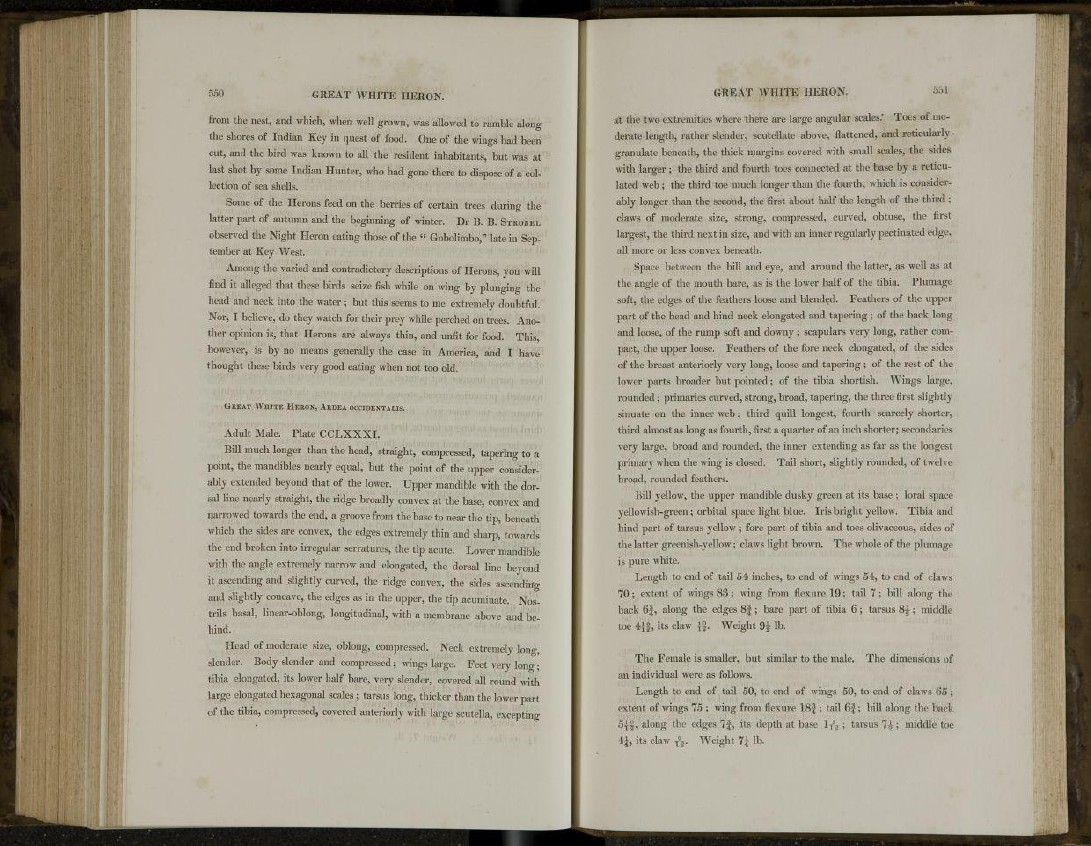
from the nest, and which, when well grown, was allowed to ramble along
the shores of Indian Key in quest of food. One of the wings had been
cut, and the bird was known to all the resident inhabitants, but was at
last shot by some Indian Hunter, who had gone there to dispose of a collection
of sea shells.
Some of the Herons feed on the berries of certain trees during the
latter part of autumn and the beginning of winter. Dr B. B. STROBEL
observed the Night Heron eating those of the " Gobolimbo,v' late in September
at Key West.
Among the varied and contradictory descriptions of Herons, you will
find it alleged that these birds seize fish while on wing by plunging the
head and neck into the water; but this seems to me extremely doubtful.
Nor, I believe, do they watch for their prey while perched on trees. Another
opinion is, that Herons are always thin, and unfit for food. This,
however, is by no means generally the case in America, and I have
thought these birds very good eating when not too old.
GREAT WHITE HERON, ARDEA OCCIDENTALIS.
Adult Male. Plate CCLXXXI.
Bill much longer than the head, straight, compressed, tapering to a
point, the mandibles nearly equal, but the point of the upper considerably
extended beyond that of the lower. Upper mandible with the dorsal
line nearly straight, the ridge broadly convex at the base, convex and
narrowed towards the end, a groove from the base to near the tip, beneath
which the sides are convex, the edges extremely thin and sharp, towards
the end broken into irregular serratures, the tip acute. Lower mandible
with the angle extremely narrow and elongated, the dorsal line beyond
it ascending and slightly curved, the ridge convex, the sides ascending
and slightly concave, the edges as in the upper, the tip acuminate. Nostrils
basal, linear-oblong, longitudinal, with a membrane above and behind.
Head of moderate size, oblong, compressed. Neck extremely long,
slender. Body slender and compressed; wings large. Feet very long;
tibia elongated, its lower half bare, very slender, covered all round with
large elongated hexagonal scales ; tarsus long, thicker than the lower part
of the tibia, compressed, covered anteriorly with large scutella, excepting
at the two extremities where there are large angular scales." Toes of moderate
length, rather slender, scutellate above, flattened, and reticularlv
granulate beneath, the thick margins covered with small scales, the sides
with larger; the third and fourth toes connected at the base by a reticulated
web; the third toe much longer than the fourth, which is considerably
longer than the second, the first about half the length of the third ;
claws of moderate size, strong, compressed, curved, obtuse, the first
largest, the third next in size, and with an inner regularly pectinated edge,
all more or less convex beneath.
Space between the bill and eye, and around the latter, as well as at
the angle of the mouth bare, as is the lower half of the tibia. Plumage
soft, the edges of the feathers loose and blended. Feathers of the upper
part of the head and hind neck elongated and tapering ; of the back long
and loose, of the rump soft and downy; scapulars very long, rather compact,
the upper loose. Feathers of the fore neck elongated, of the sides
of the breast anteriorly very long, loose and tapering ; of the rest of the
lower parts broader but pointed; of the tibia shortish. Wings large,
rounded; primaries curved, strong, broad, tapering, the three first slightly
sinuate on the inner web; third quill longest, fourth scarcely shorter,
third almost as long as fourth, first a quarter of an inch shorter; secondaries
very large, broad and rounded, the inner extending as far as the longest
primary when the wing is closed. Tail short, slightly rounded, of twelve
broad, rounded feathers.
Bill yellow, the upper mandible dusky green at its base ; loral space
yellowish-green; orbital space light blue. Iris bright yellow. Tibia and
hind part of tarsus yellow ; fore part of tibia and toes olivaceous, sides of
the latter greenish-yellow; claws light brown. The whole of the plumage
is pure white.
Length to end of tail 54 inches, to end of wings 54, to end of claws
70; extent of wings 83; wing from flexure 19; tail 7; bill along the
back 6 | , along the edges 8 | ; bare part of tibia 6; tarsus 8£; middle
toe 4|§, its claw £g. Weight 9£ lb.
The Female is smaller, but similar to the male. The dimensions of
an individual were as follows.
Length to end of tail 50, to end of wings 50, to end of claws 65;
extent of wings 75 ; wing from flexure 1 8 | ; tail 6 | ; bill along the back
5{£, along the edges 7}, its depth at base 1T
5
2 ; tarsus 7A ; middle toe
4£, its claw T
9
2 . Weight 7£ lb.